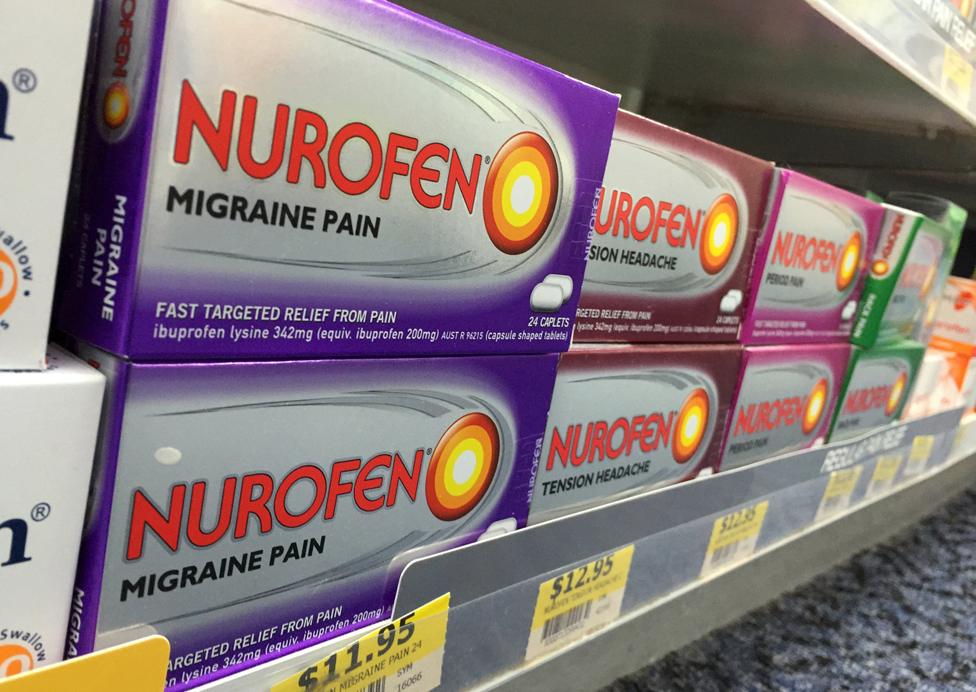The strange psychology of pain relief medicine
- Published

The manufacturer of a leading brand of painkiller has been accused of misleading customers in Australia. But how do people choose over-the-counter pain relief?
There's a whole range of Nurofen products. There are Nurofen capsules, caplets and "meltlets". Some are marketed to treat specific problems - Nurofen Migraine Pain or Nurofen Tension Headache.
But Nurofen maker Reckitt Benckiser has been ordered to take some of these "specific pain" products off the shelves in Australia. A court decided they were misleading consumers because the packaging made it seem as though they had been formulated to treat different types of pain. In fact, these products contained the same active ingredient - 342mg of ibuprofen lysine.
Reckitt Benckiser says that they are just meeting demand. They argue that 88% of people look for relief for a specific type of pain. Packaging tablets with clear labels saying "back pain" or "period pain" makes it easier for people to decide which one to get to meet their needs, they add.
But take this scenario. A customer has a packet of Nurofen Migraine Pain in their handbag. They suffer a tension headache. They buy Nurofen Tension Headache. By the Australian court's view they are completely wasting their money - it's fundamentally the same medicine in different packaging.
All of these specific pain versions cost about double the price of Nurofen's standard version in Australia. The formulations used in Nurofen's specific pain range in Australia contain lysine and sodium. The manufacturer says that this allows them to be absorbed faster than the standard version.
In the UK, similar medication is sold. Nurofen Migraine Pain and Nurofen Tension headache caplets have identical active ingredients. They contain the same 342mg of ibuprofen lysine that is in the Australian versions. But no legal action has been taken against Nurofen in the UK.
The BBC's Simon Gompertz explains whether there will be legal action against Nurofen in the UK
When someone swallows a general painkiller such as ibuprofen it's distributed around the whole body through the bloodstream, says Farrah Sheikh, a GP from Greater Manchester. Painkillers targeting specific areas will treat the areas in pain but they cannot be sent directly to a particular part of the body, Sheikh suggests.
The discrepancy in price between different versions of branded painkiller is arguably no stranger than the variation in price between brands like Nurofen, and the generic equivalents that sit near by them on supermarket shelves. Somebody could walk into a Tesco in the UK and spend £2 on a packet of 16 Nurofen when a packet of 16 generic ibuprofen tablets - an identical drug - is just 30p.
The same situation exists in the US. Some people consistently choose Advil (ibuprofen), Tylenol (paracetamol) and Bayer aspirin rather than cheaper versions.
But a study found, external that people with higher levels of knowledge - for examples doctors and pharmacists - were much less likely to buy branded medicine over generics.

"You're paying for the marketing essentially and the shiny box," argues Sheikh. She tends to recommend using cheaper generic painkillers, but says that many of her patients are still loyal to certain brands.
The placebo effect could help explain this. "Just knowing that you've taken something can make you feel better," explains Sheikh. Believing in a particular brand can also have a big impact.
In a recent study, external, researchers gave people with frequent headaches a dummy pill. Some of these placebos were packaged as branded painkillers and some weren't. The branded ones were reported to be more effective at pain relief by those in the study and were associated with fewer side effects than the placebos packaged as generic medication.

Which painkiller?
Paracetamol: Used to treat headaches and most non-nerve pains, side effects are not common and this dose can be taken regularly for long periods, but overdosing can cause serious side effects; if the pain lasts for more than three days, see your GP
Ibuprofen: Non-steroidal anti-inflammatory drugs (NSAIDs), such as ibuprofen, diclofenac and naproxen, seem to work better for arthritis or an injury. They should not be used for a long period unless you have inflammation. If you take them for long periods, there's an increased risk of stomach upset, bleeding, and kidney and heart problems
Aspirin: Produces the same type of side effects as other NSAIDs, but is not as effective as a painkiller, which means it's not usually prescribed for pain - dangerous for children under 16.

"Trust is a very important aspect in terms of our health," says Isabelle Szmigin, professor of marketing at the University of Birmingham. "People are generally much more cautious when buying medicine."
This helps explain the TV adverts for cold and flu medication every winter. Manufacturers need to create well established brands that people will remember when they get to the shop.
"There are customers who just pick up the same thing every time," adds Szmigin. This is why brand colour is so important. A bright red box on the painkiller shelf in the US is probably Tylenol while a deep blue packet in the US triggers an association with Advil.
In the UK, the colours are different. Tesco makes its generic ibuprofen silver to match the Nurofen packaging. Its generic aspirin is yellow, the same as Anadin Original. Its generic paracetamol is blue, the same as Panadol's original paracetamol packaging. In other shops ibuprofen is typically red.
Colours also have an effect on how people feel about the medicine they are taking. Red pills have been reported to be more effective for treating pain than blue, green or white pills. But blue pills make more effective tranquilisers than red ones, except for Italian men. It's been suggested this could be because blue is associated with their national football team, external.

Strong colours might help a product stand out from a crowded aisle. But it also pays to have lots of different formulations so that a brand can get as much shelf space as possible.
Even the supermarkets have tried the "specific pain" branding. Sainsbury's had "migraine relief" and also "tension headache relief" - both 342mg ibuprofen lysine tablets - placed on shelves next to their Nurofen counterparts. The latter is now no longer sold. Anyone taking both in the same day for different types of headaches would have to be aware - for safety reasons - that they are the same drug.
The type of formulation can make a difference for treatment, says the Proprietary Association of Great Britain (PAGB). The body represents manufacturers of over-the-counter medicines, says that this can be the case even if products contain the same active ingredient.
"Sometimes [manufacturers] make things that are long acting so that the medicine works over a longer period of time," explains Neal Patel, a pharmacist from the Royal Pharmaceutical Society. This could give someone hours of pain relief so that they can get some sleep. A quick-acting painkiller on the other hand, could be especially useful for people with migraines.
It's also possible that one type of tablet might be better tasting or easier to swallow than another while still being the same drug.

But the power of the placebo effect is hugely significant. "It's very powerful. If someone trusts something then it's more likely to work for them," says GP Sarah Jarvis. Some of her patients with chronic pain have refused prescriptions because they would rather buy their own brand of painkillers.
The reverse situation also happens. "I regularly have patients coming in demanding paracetamol on prescription," says Jarvis. "Sometime people make an appointment just to get it," she adds, because they think they are better quality.
"They are categorically not," says Jarvis. But people's perceptions do count.

More from the Magazine

Ibuprofen was discovered in 1961. It has joined aspirin and paracetamol in the special trinity of medicines that people keep close at hand, even when they're well. But have we come to rely on it too much?
Ibuprofen at 50: The love affair with painkillers (December 2011)

Subscribe to the BBC News Magazine's email newsletter to get articles sent to your inbox.